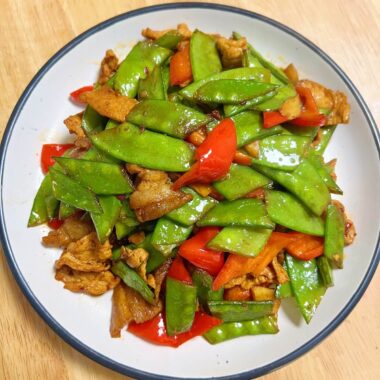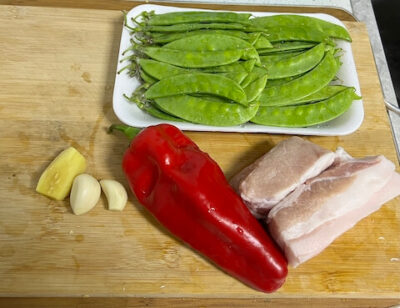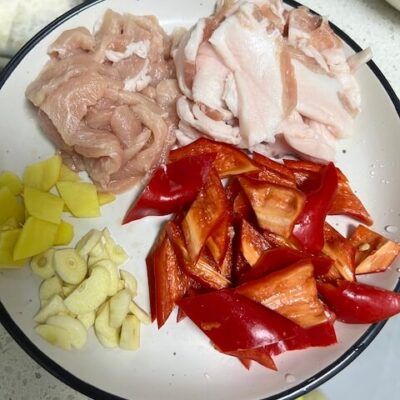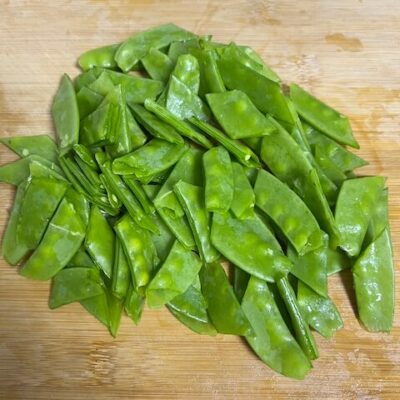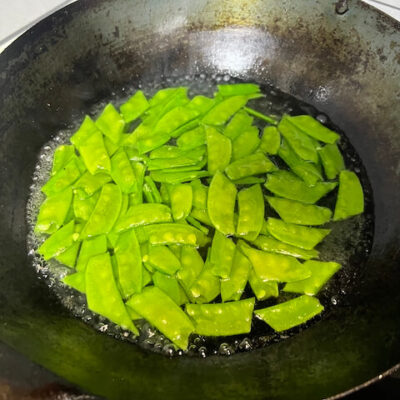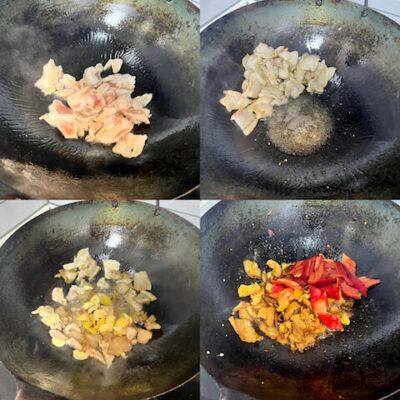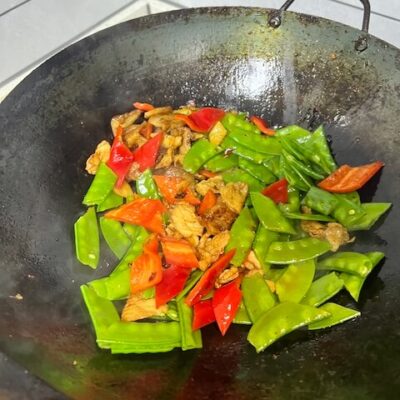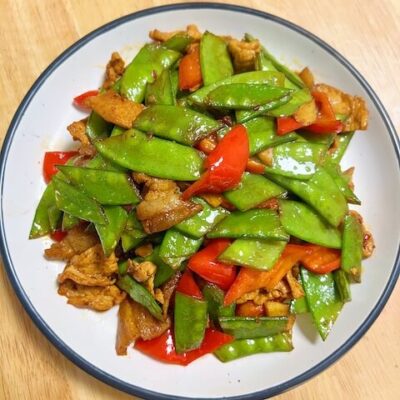Stir-fried Pork with Snow Peas
This is a simple dish with a pleasing contrast of colors, textures, and flavors. It is fairly healthy too, low in carbohydrates, and high in potassium, calcium, vitamins A & C, and protein.Sichuan chefs often mix caiziyou and pork fat or lard in equal amounts. When caiziyou is used as the oil, combined with the pork fat, the flavor and aroma are delicious. This dish, like our Hakka-style Pork Belly with Green Chilies, and Fujian Salty Rice, uses a low heat to render the pork fat and cook the lean pork. The heat is raised to medium during the finishing phase only. This keeps the pork tender, without making it browned and crispy.
Equipment
- 1 sauce pan
- 1 wok
- 1 wok spatula
- 1 sieve (for draining the snow peas)
- 1 heat safe container for hot oil
Ingredients
- 200 g snow peas
- 200 g pork belly
- 1 mild red pepper Anaheim or bell pepper
- 4 g fresh ginger
- 2 garlic
- 10 ml Pixian Doubanjiang bean paste
- 5 ml light soy sauce
- 2 ml sugar, white (granulated)
- 15 ml caiziyou roasted rapeseed oil substitute peanut oil, soybean oil, or vegetable oil
- 10 ml water
Instructions
Prepare the ingredients:
- Add water to a saucepan, enough to cover the snow peas, and set the heat to high to bring the water to a boil.
- Peel the ginger and garlic, wash the snow peas, pork, and pepper.
- Slice the pork belly, and separate the fat from the lean meat. Slice the pepper, ginger and garlic.
- Remove the head and tail of the snow peas and cut into half.
Blanch the snow peas:
- Add the snow peas to the boiling water in the sauce pan. Bring the water back to boiling, then remove the snow peas after 5 seconds and rinse with cold water to stop the cooking.200 g snow peas
Cooking:
- Add 15ml (1 tbsp) of oil to the wok over low heat, then add the pork fat, and stir-fry the fat over low heat to melt it down. Pour off half of the oil and rendered fat into a heat proof container, then add the lean pork. Stir-fry until the pork changes color, then add the ginger, garlic, and doubanjiang (bean paste). Increase the heat to medium, and stir-fry evenly until the doubanjiang is melted into the oil, then add the sliced pepper.200 g pork belly, 1 mild red pepper, 4 g fresh ginger, 2 garlic, 10 ml Pixian Doubanjiang bean paste, 15 ml caiziyou roasted rapeseed oil
- Season with the light soy sauce and sugar, and 10ml (2 tsps) of water. Add the snow peas and stir-fry evenly for 10 seconds to combine.5 ml light soy sauce, 2 ml sugar, white (granulated), 10 ml water, 200 g snow peas
- Finish.
Notes
- This recipe uses low and medium heat. The pork fat is rendered over low heat, the pork is cooked over low heat, and the garlic, ginger, and doubanjiang are added over low heat. Once the doubanjiang is melted and blended into the fat and oil, you increase the heat and add the sliced pepper.
- Unlike chemically-processed canola oil (which also comes from rapeseed), caiziyou is a roasted, expeller-pressed rapeseed oil and has a distinct flavor and aroma. You can order caiziyou from the Mala Market. If you prefer, any frying oil can be substituted.
- Blanching the snow peas brings out the color and flavor, while maintaining their crispy texture. Do not leave the snow peas in the boiling water for more than a few seconds, or they will become soft and mushy. Immediately after removing them from the boiling water, plunge them into ice water, or under cool tap water until they are cool. This stops the cooking, and keeps them nice and crispy.
- You can blanch the snow peas in your wok. However, boiling water will strip the seasoning from your wok. It's best to use a second wok or a sauce pan for this step.
Nutrition
Calories: 648kcalCarbohydrates: 13gProtein: 13gFat: 60gSaturated Fat: 20gPolyunsaturated Fat: 8gMonounsaturated Fat: 29gTrans Fat: 0.03gCholesterol: 72mgSodium: 174mgPotassium: 415mgFiber: 3gSugar: 7gVitamin A: 1163IUVitamin C: 61mgCalcium: 55mgIron: 3mg
Tried this recipe?Let us know how it was!
